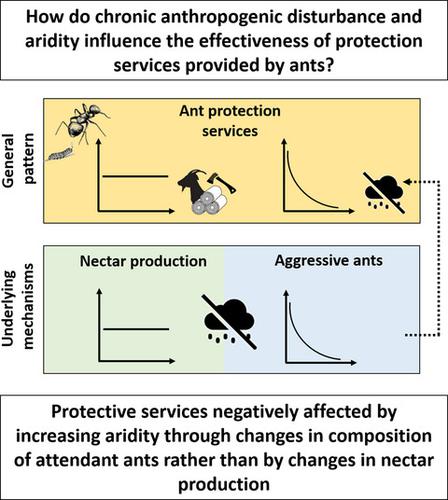Our official English website, www.x-mol.net, welcomes your
feedback! (Note: you will need to create a separate account there.)
Plant protection services mediated by extrafloral nectaries decline with aridity but are not influenced by chronic anthropogenic disturbance in Brazilian Caatinga
Journal of Ecology ( IF 5.3 ) Pub Date : 2020-07-11 , DOI: 10.1111/1365-2745.13469 Fernanda M. P. Oliveira 1 , Talita Câmara 1, 2 , José I. F. Durval 3 , Caroline L. S. Oliveira 3 , Xavier Arnan 1, 4 , Alan N. Andersen 5 , Elâine M. S. Ribeiro 1, 6 , Inara R. Leal 7
中文翻译:

由花外腺介导的植物保护服务因干旱而减少,但不受巴西卡廷加州长期人为干扰的影响
更新日期:2020-07-11
Journal of Ecology ( IF 5.3 ) Pub Date : 2020-07-11 , DOI: 10.1111/1365-2745.13469 Fernanda M. P. Oliveira 1 , Talita Câmara 1, 2 , José I. F. Durval 3 , Caroline L. S. Oliveira 3 , Xavier Arnan 1, 4 , Alan N. Andersen 5 , Elâine M. S. Ribeiro 1, 6 , Inara R. Leal 7
Affiliation

|
- Most terrestrial species occur in human‐modified landscapes that are experiencing climate change. In addition to direct impacts on species, both anthropogenic disturbance and climate change can have important effects through changes in species interactions, including the disruption of ecological services provided by them.
- Here we investigate how chronic anthropogenic disturbance (CAD) and aridity affect the effectiveness of plant protection services provided by ants to plants bearing extrafloral nectaries (EFNs).
- The study was conducted across 13 01‐ha plots distributed along CAD and aridity gradients in Caatinga vegetation of northeastern Brazil. We focused on Pityrocarpa moniliformis, the most abundant and widely distributed EFN‐bearing tree species occurring in our study area, and we used experimental attack rates on termites as a measure of effectiveness of ant protection services. We investigated the relative roles of nectar production (volume and concentration) and ant species composition in mediating the effects of CAD and aridity on the effectiveness of protection services.
- Attack rates by ants declined with increasing aridity but were not related to CAD. The volume of extrafloral nectar declined with increasing CAD but was not affected by aridity, whereas the concentration was not related to either CAD or aridity. The composition of attendant ant species varied with aridity but not with CAD.
- Synthesis. Our findings suggest that CAD does not affect plant‐protection services mediated by EFNs in Brazilian Caatinga. However, ant‐protection services declined with increased aridity, and this occurred through changes in the composition of attendant ant species rather than by changes in the production of extrafloral nectar. Such a response to increasing aridity highlights the vulnerability of EFN‐bearing plants to climate change through decreased predation of herbivores.
中文翻译:

由花外腺介导的植物保护服务因干旱而减少,但不受巴西卡廷加州长期人为干扰的影响
- 大多数陆地物种都发生在经历气候变化的人类改造景观中。除了对物种的直接影响之外,人为干扰和气候变化都可以通过物种相互作用的变化,包括破坏它们所提供的生态服务,而产生重要影响。
- 在这里,我们研究了慢性人为干扰(CAD)和干旱如何影响由蚂蚁为带有花蜜的植物(EFNs)提供的植物保护服务的有效性。
- 该研究是在巴西东北部Caatinga植被中沿CAD和干旱梯度分布的13个01公顷土地上进行的。我们集中研究了研究区域中最丰富,分布最广的带有EFN的树种-Pityrocarpa moniliformis,并使用对白蚁的实验性攻击率来衡量蚂蚁保护服务的有效性。我们调查了花蜜产量(数量和浓度)和蚂蚁物种组成在介导CAD和干旱对保护服务有效性的影响方面的相对作用。
- 蚂蚁的攻击率随着干旱的增加而下降,但与CAD无关。花蜜的体积随着CAD的增加而下降,但不受干旱的影响,而其浓度与CAD或干旱无关。伴随的蚂蚁种类的组成随干旱而变化,但与CAD无关。
- 综合。我们的发现表明,CAD不会影响巴西卡廷加州EFN介导的植物保护服务。但是,随着干旱的增加,蚂蚁保护服务下降,这是由于伴随的蚂蚁物种组成的变化而不是花外花蜜产量的变化引起的。对干旱增加的这种反应突出表明,携带EFN的植物通过减少草食动物的捕食而容易受到气候变化的影响。









































 京公网安备 11010802027423号
京公网安备 11010802027423号